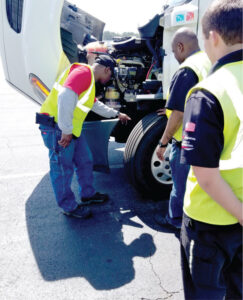by
TIM VOGT, a driver trainer for XPO based in Lawrenceville, Georgia, knows that there is no typical background for a truck driver. At driving school, Vogt meets all kinds of aspiring drivers.
“I’ve had a music teacher and a woman that drove a school bus and people that had office jobs and did medical sales,” Vogt said. “I’ve had older people, and I’ve had people who had just turned 21. We had a guy go through the school several years ago who had retired — he was in his 70s — but he always had wanted to drive a truck. So, we gave him the opportunity to do that, and he did it for years before he retired again.”

For trucking companies, filling positions for drivers and mechanics is a crucial, complicated process that never eases up. Technical training programs, including both in-house and third-party offerings, play a central role in recruitment efforts, especially by introducing new workers to the field and taking inexperienced trainees and transforming them into capable team members.
Jeff Arledge, director of maintenance for J&M Tank Lines, said working with technical training programs is about keeping an eye on both the present and the future.
“It’s like farming,” Arledge said. “You’ve always got to be looking to grow your next crop of workers.”
Among J&M’s efforts, the company currently works with the Diesel by Distance program for aspiring mechanics at Wallace State Community College in Hanceville, Alabama. Classes are held two weekends each month in person and two weekday nights each week remotely, allowing team members to learn to become mechanics while continuing to work.
Arledge said the competition for students from the program is stiff, with large, national employers vying with local and regional players for graduates.

An important component of training today for drivers and mechanics is the electronics and computer systems, and Arledge said school technical programs such as the one at Wallace State are excelling in that area.
“Most of the time the first thing you grab now is a laptop when you’re a mechanic,” Arledge said. “The schools are doing a great job with that part of training, and the younger workers are comfortable plugging their laptop in and downloading programs and figuring it out. They were built for this.”
Arledge said one area where schools could improve is elevating the “reality” of the real-world circumstances they train in. For instance, trainees may learn to change tires with old tires and aged rims that do not quite mirror what they will find in the field.
“Training is still usually in a controlled environment,” Arledge said.
J&M Tank Lines recently enrolled some young, promising employees from its wash bays into the Diesel by Distance program to gain new skills and credentials and prepare to become mechanics. While the employees gain technical training at the school, J&M also helps them apply those lessons to real-world scenarios back at work.
“I think it helps them to develop faster to have that concept between learning the book end of it and then learning the hands-on part at the same time,” he said.
In addition to sending employees to Wallace State to learn, Arledge said J&M also has hired mechanics straight from the program. As part of J&M’s efforts, Arledge has spoken to students at the school, and J&M has hosted students to shadow mechanics for a day.
By working to help current employees train through Wallace State while also recruiting new students from the program, J&M is making an important effort both for recruitment and retention of the workforce.
Similarly, Vogt said XPO’s in-house driving school supports both recruitment and retention. Vogt said it is natural that those who train at an in-house school would have longer tenures with the company. They gain a comfort level driving through the program, so they also gain comfort with the company that helped them.
Vogt said XPO’s current driving school program has been available in its current form for about two years. The course takes enrollees from zero commercial driving experience to being a driver with XPO in seven weeks. Five weeks of that period is driver training, and the other two weeks are supervised on-the-road training.
“When they graduate, they have full-on driver status,” Vogt said. “They are out on their own doing the work.”
The education is a paid one for trainees. XPO covers the cost under an agreement that trainees commit to working with the company for a set period. Vogt said one of the benefits of having an in-house driving school is that prospective drivers do not just receive training to earn a CDL — they earn XPO-specific training to work for the company.
“We’re able to really tailor that education to ‘This is how we want you to drive, and this is how we want you to be professional and interact with customers and handle freight,’” Vogt said. “When they come out, they’re just ready to go — they can hit the ground running instead of us saying, ‘OK, you have a CDL, but you haven’t really had a whole lot of practical instruction on what exactly you’re supposed to do with it.’”
Vogt said XPO has 130 driver school locations in 30 states. Overall, XPO graduated more than 1,700 students from its schools in 2022 — almost double the total from 2021.
“The schools are definitely a growing source of new talent for XPO,” Vogt said.
He said the students that come out of XPO’s driver schools have better safety records and stay employed longer than those who come from third-party schools.
“A great deal of driver training is about teaching good habits,” Vogt said. “If you have somebody from the very beginning, before they know anything about driving a truck, you can instill those good habits from the very beginning of their career.”
Vogt said XPO’s driver training has evolved to meet the demands of the industry, and he noted that in-house driving schools have become increasingly popular and sophisticated. Vogt said XPO’s program formerly was unpaid and lasted longer, but as competition for drivers increased, that approach lost appeal for potential drivers. In response, XPO transitioned to a paid format.
Vogt said XPO offers schools based on the needs of individual service centers — “The demand for drivers is very local and regional.” For instance, service centers short on experienced applicants would be more likely to have the local XPO driving school run classes than service centers flooded with experienced applicants.
“It’s very flexible — it’s not something that’s a fixture we use all the time,” Vogt said.
Vogt said driving can be intimidating but excellent training programs help people overcome that notion. In that way, training programs can be profoundly meaningful for both new workers and the companies that hire them.
“I have watched it change a lot of people’s lives for the better,” Vogt said. “And just to see the satisfaction and the pride that they have coming out of the school and being able to go out there on the highway and drive whatever and deliver whatever in any kind of weather in any kind of traffic and do it competently — it’s a huge boost for them. For me, it’s really fun to watch it happen.”



